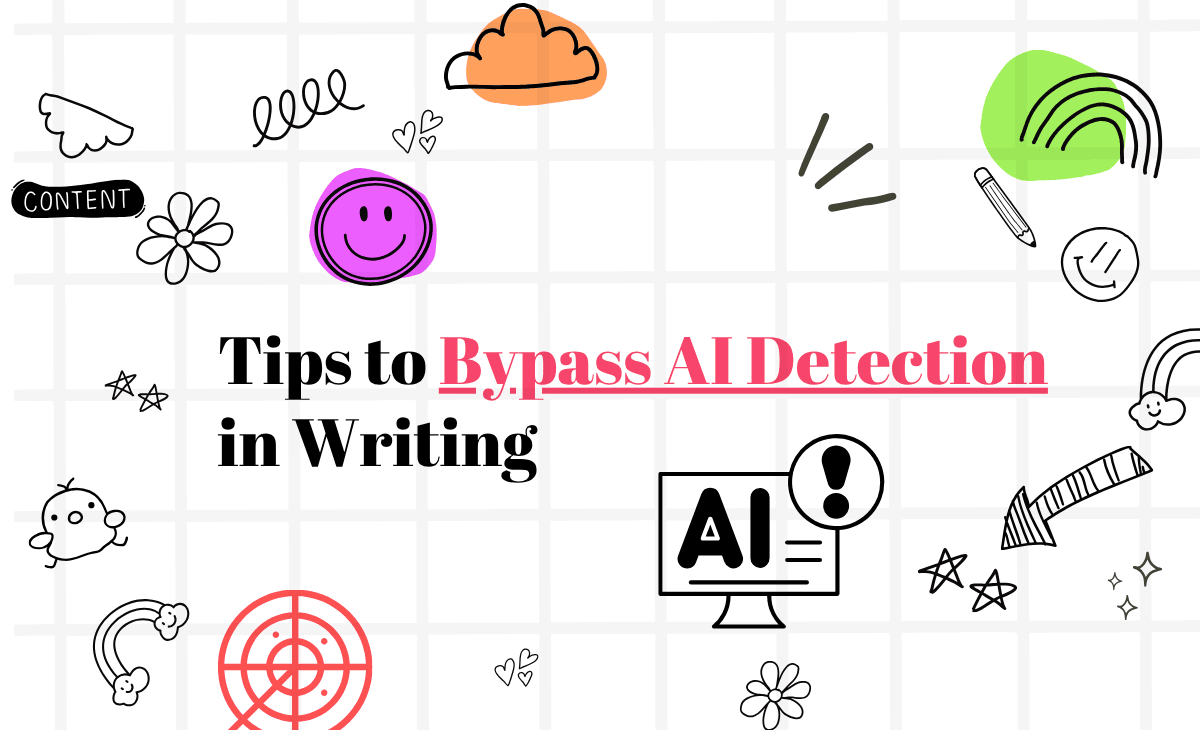One of the major challenges of using AI for content creation is remembering tips to bypass AI detection in writing, as our growing love for AI has led detectors like GPTZero, Turnitin, and others to take their job more seriously. It poses a significant challenge for students and marketers to maintain a credible presence both offline and online.
Being flagged by these detectors is a direct question of your credibility and authenticity, and also disrupts SEO. Imagine presenting a paper or promoting a new product launch, and it gets flagged as AI-generated.
It’s not only embarrassing and prompts penalties, but also takes away all your hard work and the trust people had put in you. But, here is the thing: completely letting go of AI-generated content in a time like this is letting go of an easy upper hand.
But the slope is not as slippery as it seems. Outsmarting the detectors is not that tough, and all it takes is a bit of careful understanding.
How AI Detectors Work?
First things first, if you wish to bypass AI detection in writing, you must focus on its design. Understanding how it works is the easiest way to formulate a strategy to outsmart it.
You can think about AI detectors as a security check, say in an airport or at a border. Like security checks, AI detectors scan your writing to understand if it's fit to pass as human-generated content. That’s why there is now a growing demand for AI detection scores to prove authenticity in both marketing and academic settings.
Here’s a quick example of GPT Zero working on a ChatGPT-generated prompt:
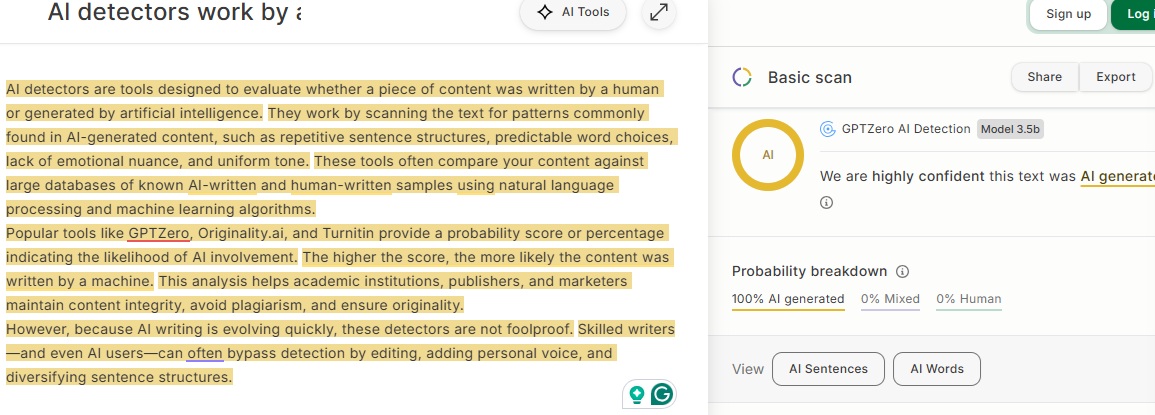
ZeroGPT wasted no time in declaring it AI-generated content, and all it took was one click. Here’s how it does it:
Like AI writing tools, AI content detectors also operate on natural language processing (NLP) and machine learning (ML) to detect AI-generated content. The logic behind it is simple: it breaks down patterns, words, phrases, and characters to understand if there’s AI involved.
- Pattern Recognition: The basic principle of AI detection is pattern recognition. It works on the simple logic of picking up cues that are an obvious sign of AI-generated content.
For example: AI writing is rigid and rarely has a conversational tone, as you can also see in the sample write-up. Secondly, AI is known to use certain words like groundbreaking, delve, harness, game-changing a lot, which in turn triggers the detectors.
- Perplexity & Burstiness Metrics: The concept of perplexity is about assessing how predictable the sentence is. Where a low perplexity score indicates the presence of AI, with the presence of smooth and refined sentences.
Burstiness in AI detection means a variation in a given sentence. Needless to say, a low burstiness score is a red flag, as it is usually AI with the same repetitive patterns.
💡Quick Fact: AI detectors are similar to AI writing tools in terms of technology, but they are specifically trained on large datasets of AI-generated and human-written content to learn the differences between the two. It is usually about identifying syntax, semantics, and rhythm.
So, if you wish to bypass a detector, it’s simple: your writing needs to be less rigid, offer fresh perspective, and sound more human.
Top 10 Tips to Bypass AI Detection in 2025
Mix Sentence Lengths and Structure
This is the easiest way to break down the AI detector's pattern recognition. You must have noticed that AI not only maintains the same tone but typically has the same sentence structure and length. You have to induce chaos in that setup.
The idea is to mimic the human thought, so a quick mix of complex thoughts followed by a punchy or conversational tone always works. As you are breaking out from the robotic uniformity and pattern.
Use Active Voice and a Colloquial Tone
You will rarely find AI talking or addressing you in its writing. One of the major giveaways of AI-generated writing is that it rarely uses an active voice. All it does is provide a generic narrative that is addressed to no one in particular.
Moreover, AI-generated content is always formal and stringent. So the moment you shift the narrative to a personalized tone, you win AI detection. Here’s a quick example:
This is what Google Gemini had to say as I prompted it to write on an AI writing tool:
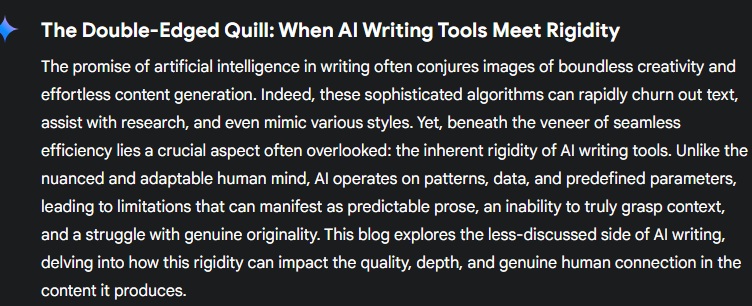
▶️ Not only does it use words and phrases that are suffocating, but it weaves a narrative that’s frustrating to read. It is boring, complicated, and never attempts to form a connection with the readers.
💡But here’s how you can bypass any detector with the same prompt once you make a few quick changes like adding a personal narrative, forming connections, and so on:
“Writing ain’t easy, and meeting deadlines while maintaining that creative flair? Yeah, that’s a whole other level of stress. I have lost count on how many times I have just stared blankly at the screen. This is where AI comes in to save the day. The promise of artificial intelligence in writing often conjures images of boundless creativity and effortless content generation….” And you continue from here on and twerk the narrative as much as you can so that it sounds personal.
Add Idioms and Figurative Language
AI doesn't rely on idioms to prove its point. You will never find AI to rely on“ Sophie’s choice” or “Rome was not built in a day” to prove its point. If you wish to bridge the gap between AI Writing vs. Human Writing and get the AI detectors to like you, you have to bring in the cultural nuances.
Making AI writing undetectable includes catching up on these details that are alien to AI and crafting a piece that has both the efficiency of AI and the brilliance of the human mind.
Insert Personal Anecdotes
A quick mini story to reflect your struggle is always going to make it through AI detection unscathed. Here is the thing: since AI doesn't have any lived experience, it has no interpersonal anecdotes to rely on.
On top of that, AI cannot imagine a scenario, as all it has for itself is the prompt you feed and the datasets to track it. Here’s a quick snapshot of ZeroGPT for the above prompt, even though the last part is AI-generated to establish the same:
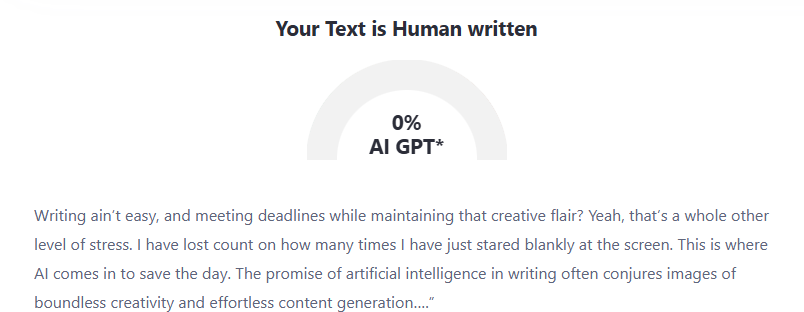
💡Quick Fact: The reason even the last part of the text was not flagged by the generator is that the narrative breaks the pattern. The inclusion of a personal story and an attempt to connect could successfully manipulate its triggers.
Vary Formatting and Use Visual Breaks
AI content not only reads boring but looks boring too. It will give you a 2000-word blog in a format that looks for or less like a ledger. It is not only very tiring to read, but it also sets off the AI detectors on you immediately.
Breaking the pattern is not always about your sentences, sometimes it's about how it looks and how skillfully it can pass as human. So, adding bullet points wherever it is needed or writing quick facts or anecdotes in between the blog is an easy way to go.
Avoid Overused AI Phrases
You won’t need AI detectors; the moment you read, “In today’s fast-paced world…”, even you will know something is up. There are certain giveaways of AI-generated writing, and relying on overused AI phrases is one of them.
Instead of writing the same thing, you can always rely on a new observation, a quirky quote, or even a bold statement that can help enhance the narrative. The moment you rely on the same old pattern, you are creating a space for the AI detectors to come for you.
Replace Clichés With Fresh Hooks
Not every blog needs to begin with“ a groundbreaking discovery” or optimizing your workflow. It can also be about how you have missed your night’s sleep as you try to organize the meeting, or spilled coffee on your keyboard while struggling to be mindful.
AI doesn’t know all these challenges, and hence, it becomes easier for you to bypass any detector the moment you start being creative. It’s not that you have to keep your audience on the edge throughout the thing. But breaking out of the known clichés is always a great idea to generate AI detector-proof content.
Edit Manually (Always!)
The best way to make an AI detector look the other way is to make sure you have the final say. AI-generated content will always be grammatically correct with its perfect English and sentence construction. But it's up to you to tweak tone, tighten structure, and infuse personality so that your credibility is not questioned.
Add Contradictions
The way artificial intelligence is trained, it cannot keep up with presenting both sides of an argument. You will rarely find a hint of contradiction in AI-generated work, as it rarely expresses doubt.
So, a sprinkle of“ to be honest” or “maybe if we/ you” is another safe bet to make sure you don’t have to struggle at the AI checkpoint.
Using Humanize AI
What happens if you're in a setup where editing each piece of work manually just isn’t practical? Maybe you don’t have the manpower or time to tweak every sentence, or you find it overwhelming to fine-tune language just to bypass AI detectors. In many cases, writers—especially non-native English speakers—use AI tools simply to express themselves more clearly. But even then, they’re often unfairly flagged by detectors, despite the content being original and ethically written.
That’s exactly why Humanize AI was built: to bridge this gap for individuals and teams who can’t always produce perfectly "human-like" content on their own. Whether you’re refining your own ideas or using AI as a tool to help with language, Humanize AI ensures your message stays authentic—without the risk of false detection.
| AI Writing Tool | Humanize AI |
| “Struggling with writer’s block, tight deadlines, or endless edits? Say hello to XYZ—an AI writing assistant designed to make your content creation smoother, faster, and smarter. Whether you're crafting blog posts, social media captions, emails, or even full-length articles, XYZ helps you generate ideas, refine your tone.. “ | Writer's block, deadlines, and edits-from thunderstorms of creativity; we've been there too. This is where XYZ enters the scene-not to substitute your creativity, but to aid it. Imagine it working behind the scenes; a writing buddy that motivates you in idea brainstorming, tone shaping, and putting ideas into words faster and with way less stress. Be it blog posts, social captions, emails, or full-fledged articles, XYZ makes writing easy, flowing, and more confident. |
💡Quick Review: Not only does the humanized AI version read more fun and personal, but it also passes as 100% human. This tool is really important if your context is falsely detected by AI detectors.
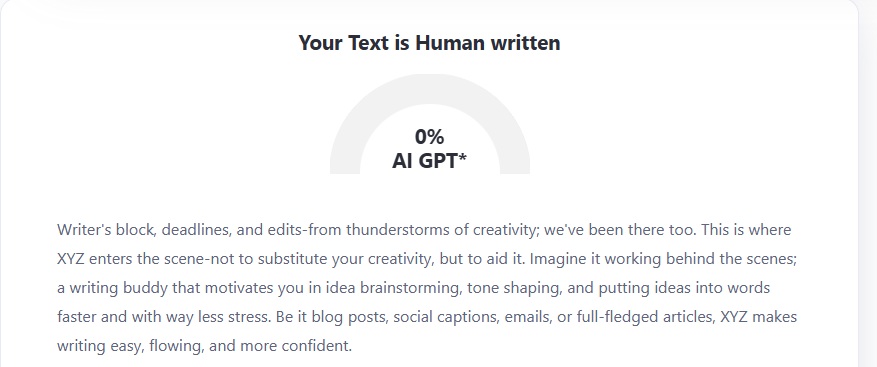
Conclusion
As a marketer or a student, it is easy to pinpoint the many faults of AI-generated writing, but it’s equally tough not to rely on it. Artificial intelligence is fast, effortless, and comes in handy, especially in a setup with limited manpower.
But, as AI becomes more efficient, AI detection also becomes smarter and more difficult to manipulate. However, luckily for us, no matter how advanced AI detection gets, there will always be tricks to surpass it as long as we are in charge.
Honestly, it’s simple; all you have to do is keep on checking for personality, variation, and genuine connection, or rely on tools like Humanize AI to bypass false AI detection in writing.

